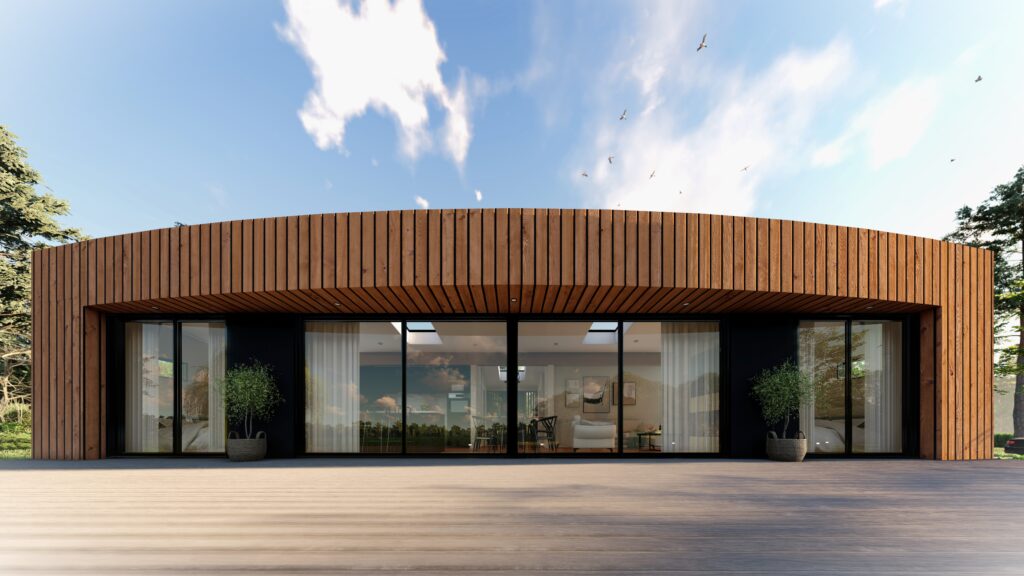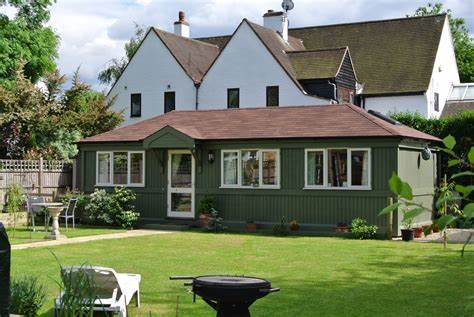
We offer a range of buildings that can be installed as a residential annexe on the drive or in the garden of your main house without the need for planning approval. This is possible because laws relating to touring caravans also apply to year-round accommodation on a larger scale, so your new building is regarded as a ‘static caravan’ or ‘mobile home’.
Overview of the law
The legal definition of a ‘caravan’ is any structure designed for human habitation that is capable of being transported. A ‘mobile home’ is a type of caravan that is not meant to be directly towed on road by a vehicle. Regarded as an article of movable personal property (known as a ‘chattel’), there is no public law preventing one being kept in your garden, but there are laws regulating the use of land.
Use
Your new mobile home must be used by members of the household in connection to the enjoyment of the house or as extra accommodation for visiting guests, provided occupants continue to use the facilities of your house. Essentially, this ensures that your new living space is not regarded as a separate or independent dwelling or business, and a ‘material change of use’ has not occurred.
Location, size and construction
It must be located in the ‘curtilage’ of the your dwelling house, not surrounding land. The term curtilage is defined as a garden, but can include parking areas, access roads, vegetable plots, children’s play areas, and stables (where horses are kept for pleasure rather than agricultural use). The curtilage may not necessarily be marked off or enclosed, but should be clearly attached to your house or serving the purpose of the house in some useful and intimate way. We can assemble your new living space on-site (even if access is restricted) from many precision engineered, prefabricated pieces, running services from your main house. In terms of conforming as a caravan, the law focuses on the structure, which must be movable in one whole unit and capable of transport down a hypothetical road, even if access to a road may require craning over buildings or complicated procedures. So you can have one of our buildings installed even if access to a road is impossible and the building can’t actually be lifted out. The maximum size you can go to is 20 x 6.8m (approx 65 x 22ft), and the internal floor to internal ceiling height no greater than 3.05m. This provides enough space for five or more bedrooms with kitchen, living space and toilets. You can consider any of our buildings that fall within the maximum size stated. The layout, as well as the doors and windows, can be configured to suit your needs.
What to expect from a mobile home
Don’t confuse the term ‘caravan’ or ‘mobile home’ with experiences of holiday parks and substandard comfort (paper thin walls, floors you can feel moving underfoot, and freezing cold in winter months) and ugly designs. Landscape Living offers spaces you can be proud of. Solid, well-insulated and beautiful with all the luxury of conventional residential living. ….
Advantages over alternative planning routes
Adding a new living space as a ‘mobile home’ obviously comes with the benefit of not needing to obtain planning approval, but it also has its advantages over Permitted Development or seeking traditional Planning Approval.
Permitted Development
As a home owner you may be familiar with permitted development rights that allow the construction of outbuildings, extensions, sheds, etc without the need for planning approval. However, there are a number of restrictions. Most importantly, it won’t allow you to add living accommodation or a structure with kitchen and bathroom. You are also much more restricted in terms of height, positioning, the percentage of the total available area it can take up, and floor space. And if your property falls within a greenbelt or conservation area, or area of outstanding natural beauty or scientific interest, permitted development may not be possible at all. The use of a ‘caravan’ is not a permitted development right or even ‘development’. Caravans are not ‘buildings’ or ‘structures’, so these restriction won’t apply to your mobile home. It means you could create living accommodation, including kitchen and bathroom, on a much larger scale, more freely.
Planning Approval
You could seek traditional planning approval for your new living space. However, there is a high chance of refusal, and a ‘caravan’ can be significantly larger than most buildings capable of obtaining planning approval as annexes. Planning may also dictate the style of building you are allowed. If your new space will have living accommodation, include a kitchen and bathroom, or is larger than permitted development allows, you will need to seek planning approval when not opting for the mobile home route. Meeting UK Building Regulations will likely also be a requirement rather than option.
What to do next
If you would like one of our buildings in the grounds of your main house, as a mobile home without the need for planning approval, we advise applying for a Lawful Development Certificate (LDC). It is issued by your local planning authority (LPA). Once granted, the certificate will remain valid for the use or development described in it, on the land it describes, as long as the use doesn’t change. Applying involves form-filling, producing a site plan, and providing supporting evidence to show how your new living space will conform as a mobile home under caravan laws. You may wish to apply yourself, or we can do it for you with our Mobile Home Planning Service.
Mobile Home Planning Service
Applying for a Lawful Development Certificate (LDC) can be tricky and time-consuming, and getting something wrong can ruin your chance of the council agreeing. While we obviously can’t guarantee a positive outcome, we can manage the application process for you with our Mobile Home Planning Service. We would work with you to obtain the information required, before completing the application form and submitting it with location plan and supporting covering letter. Once the council has made a decision, we report to you on the outcome.
Statutory Declaration
We recommend also including a ‘statutory declaration’ as part of the LDC application. The authorities may be concerned about the use of the mobile home (referred to as a separate unit contention issue), being that it likely has all the facilities to allow independent living. The statutory declaration is a legal document declaring under oath and in the presence of a lawyer how your mobile home will be used, and it will strengthen your application. As part of our planning service, we will provide a document that you can take to your solicitor, who will probably charge you between £10 and £30 for their time.
Applying yourself
Alternatively, if you’d prefer to apply for a Lawful Development Certificate (LDC) yourself, rather than take advantage of our Mobile Home Planning Service, we have outlined what to do, and you will find useful examples in the next section.
Your local planning authority (LPA) is there to help, and you may initially want to write an informal letter detailing the location and use of the proposed ‘caravan’. If lawful, we advise you to apply for a Lawful Development Certificate (LDC). This offers extra peace of mind, because a response to your informal letter is not legally binding. We will also ask to see a copy of your LDC before proceeding with your order. There will be a fee associated with an LDC application (£100-£200), and often a fee for a written response to an informal letter. Costs vary, and you may want to phone your council and ask the planning department first. The application form you need is a ‘Lawful Development Certificate Application for a Proposed Use’. It can be found by searching on the website of your council or by calling the council planning office and asking for one to be posted to you. Alternatively, you can apply online: www.planningportal.gov.uk You will need to include a site location plan with your application. If you don’t already have one of your property, you can purchase online (www.streetwise.net or www.getmapping.com). A 1:500 Site Plan or 1:1250 Location Plan is usually ideal. You could also indicate where on the map the mobile home will be sited. As mentioned above, we recommend also including a ‘statutory declaration’ to strengthen your application.
More information can be found at www.planningportal.gov.uk





